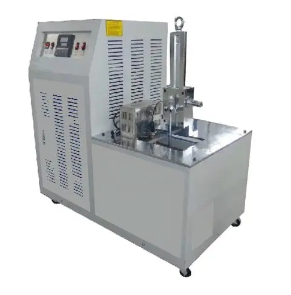- Qinsun Instruments Co., Ltd.
- Tell:+86-21-6780 0179
- Phone:+86-17740808215
- Address:No. 2578 Minhang District Gu Dai Road, Shanghai
- Contact:Mr. Li
- QQ:846490659
Rubber low-temperature brittleness testing machine

The rubber and plastic ultra-low temperature brittleness testing machine is used to measure the temperature at which rubber and plastic specimens are subjected to impact damage under specified conditions, which is known as the brittleness temperature. It can compare the performance of non hard plastics and other elastic materials under low temperature conditions, and evaluate the advantages and disadvantages of temperature and low temperature performance. Therefore, it is indispensable in the control of scientific research materials and production processes.
This instrument is a compressor refrigeration equipment designed and developed according to GB/T 15256 and GB/T5470 standards. This equipment adopts a cascade compressor refrigeration technology, utilizing the principle of thermal balance and cyclic stirring method, to achieve automatic and uniform cooling and constant temperature of the sample. This equipment is divided into two types: rubber low-temperature brittleness testing machine and plastic low-temperature brittleness testing machine.
Technical parameters:
1. Temperature control range: -80 ℃ (room temperature ≤ 25 ℃) (there are three models available for customers to choose from: -60, -70, -80 ℃)
2. Cooling rate:
0 ℃~-20 ℃ 1.2 ℃/min
-20 ℃~-30 ℃ 1.0 ℃/min
-30 ℃~-60 ℃ 0.7 ℃/min
-40 ℃~-60 ℃, about 0.7 ℃/min
-60 ℃~-80 ℃, about 0.5 ℃/min
Note: The usage environment is at room temperature (23-25 ℃), and the compressor's temperature dissipation effect can be maintained during operation. The side doors can be fully opened.
3. After constant temperature, the temperature fluctuation within 3 minutes of the test is less than ± 0.5 ℃
4. External dimensions: 900 x 505 x 800mm (length x width x height)
5. Studio dimensions: 220 x 170 x 70mm (length x width x height)
6. Cooling medium: ethanol or other non freezing liquids
7. Mixing motor: 15W
8. Working power supply 220V~240V, 50Hz, 2kW
Structural principle:
This equipment consists of a refrigeration compressor main body, a heating device, an electronic control box, a cooling tank, a cooling medium circulation system, an automatic alarm device, and other parts. After starting the refrigeration switch, the compressor starts working and the refrigeration system enters the official working state. The refrigeration compressor operates continuously, and as it approaches the set temperature, the heating device in the cooling tank begins to provide heat proportionally to balance the excess cooling generated by the refrigeration system and achieve constant temperature. Stirring can continuously circulate the cooling medium in the cooling tank, ensuring a uniform and consistent temperature.
Usage:
1. Inject refrigerant (usually industrial ethanol) into the cold well, and the injection amount should ensure that the distance from the lower end of the gripper to the liquid level is 75 ± 10mm.
2. Connect the power, and the temperature controller and timer display lights will light up.
3. Clamp the sample vertically onto the gripper. The clamping should not be too tight or too loose to prevent deformation or detachment of the sample.
4. When the temperature reaches the set value, press the gripper to start freezing the sample. After the temperature stabilizes, the machine will automatically start the timing control switch (or press the stopwatch) for timing. The freezing time for the sample is specified as 5.0 ± 0.5min for rubber and 3.0 ± 0.5min for plastic. During the freezing period of the sample, the temperature fluctuation of the freezing medium shall not exceed ± 1 ℃.
5. Pull the impact handle to allow the impactor to impact the specimen within half a second.
6. Remove the sample, bend it 180 ° in the direction of impact, and carefully observe for any damage.
7. After the sample is impacted (each sample is only allowed to be impacted once), if damage occurs, the temperature of the freezing medium should be raised; otherwise, the temperature should be lowered and the test should continue. By repeated testing, determine the low temperature at which at least two samples are not damaged and the temperature at which at least one sample is damaged. If the difference between these two results is not greater than 1 ℃, the test is completed.





